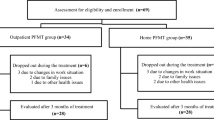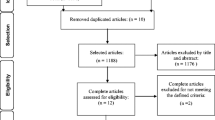Abstract
Introduction and hypothesis
The aim of this study was to assess whether bladder training (BT) combined with high-intensity pelvic floor muscle training (BT + PFMT) results in better outcomes in the short term than BT alone on female urinary incontinence (UI).
Methods
We randomly assigned 108 women with diagnoses of stress UI (SUI, n = 50), urgency UI (UUI, n = 16), or mixed UI (MUI, n = 42) to 6 weeks of BT + PFMT or BT alone (control group). The primary outcome measure was self-reported improvement. Secondary outcome measures were UI severity, symptom distress, quality of life (QOL), mean number of UI episodes and micturitions per day, and pelvic floor muscle strength and endurance (PFME).
Results
Overall and in the SUI and MUI subgroups, significantly more patients in the BT + PFMT group reported cured and improved symptoms. Overall and in SUI patients, the BT + PFMT group also improved to significantly greater degree in UI severity, symptom distress, QOL, daily UI episodes, and PFME. The only parameter showing more improvement in patients with UUI was QOL, and UI severity in patients with MUI (p < 0.05). There were no other significant differences between the two study groups in overall and subgroup analysis (p > 0.05).
Conclusions
High-intensity PFMT combined with BT is more effective than BT alone in the short term for treating UI or SUI. It appears that the combination therapy may also lead to greater benefits for patients with UUI and MUI. Based on the results of this study, further studies with larger sample sizes (for UUI) and long-term follow-ups are warranted.

Similar content being viewed by others
References
Haylen BT, de Ridder D, Freeman RM, Swift SE, Berghmans B, Lee J, Monga A, Petri E, Rizk DE, Sand PK, Schaer GN, International Urogynecological A, International Continence S (2010) An International Urogynecological Association (IUGA)/International Continence Society (ICS) joint report on the terminology for female pelvic floor dysfunction. Neurourology and urodynamics 29(1):4–20. doi:10.1002/nau.20798
Ayeleke RO, Hay-Smith EJ, Omar MI (2013) Pelvic floor muscle training added to another active treatment versus the same active treatment alone for urinary incontinence in women. Cochrane Database Syst Rev 11, CD010551. doi:10.1002/14651858.CD010551.pub2
Wyman JF, Fantl JA, McClish DK, Bump RC (1998) Comparative efficacy of behavioral interventions in managing female urinary incontinence. Continence Program for Women Research Group. Am J Obstet Gynecol 179(4):999–1007
Bradley CS, Rovner ES, Morgan MA, Berlin M, Novi JM, Shea JA, Arya LA (2005) A new questionnaire for urinary incontinence diagnosis in women: development and testing. Am J Obstet Gynecol 192(1):66–73. doi:10.1016/j.ajog.2004.07.037
Hung HC, Hsiao SM, Chih SY, Lin HH, Tsauo JY (2010) An alternative intervention for urinary incontinence: retraining diaphragmatic, deep abdominal and pelvic floor muscle coordinated function. Man Ther 15(3):273–279. doi:10.1016/j.math.2010.01.008
Lagro-Janssen AL, Debruyne FM, Smits AJ, van Weel C (1992) The effects of treating urinary incontinence in general practice. Fam Pract 9(3):284–289
Sandvik H, Seim A, Vanvik A, Hunskaar S (2000) A severity index for epidemiological surveys of female urinary incontinence: comparison with 48-hour pad-weighing tests. Neurourol Urodyn 19(2):137–145
Cam C, Sakalli M, Ay P, Cam M, Karateke A (2007) Validation of the short forms of the incontinence impact questionnaire (IIQ-7) and the urogenital distress inventory (UDI-6) in a Turkish population. Neurourol Urodyn 26(1):129–133. doi:10.1002/nau.20292
Uebersax JS, Wyman JF, Shumaker SA, McClish DK, Fantl JA (1995) Short forms to assess life quality and symptom distress for urinary incontinence in women: the Incontinence Impact Questionnaire and the Urogenital Distress Inventory. Continence Program for Women Research Group. Neurourol Urodyn 14(2):131–139
Hay-Smith EJ, Bo Berghmans LC, Hendriks HJ, de Bie RA, van Waalwijk van Doorn ES (2001) Pelvic floor muscle training for urinary incontinence in women. Cochrane Database Syst Rev 1, CD001407. doi:10.1002/14651858.CD001407
Shamliyan T, Wyman J, Kane RL (2012) In: Nonsurgical Treatments for Urinary Incontinence in Adult Women: Diagnosis and Comparative Effectiveness. AHRQ Comparative Effectiveness Reviews, Rockville (MD)
Hashim H, Abrams P (2006) Pharmacological management of women with mixed urinary incontinence. Drugs 66(5):591–606
Lemack GE, Zimmern PE (1999) Predictability of urodynamic findings based on the Urogenital Distress Inventory-6 questionnaire. Urology 54(3):461–466
Glazener CM, Lapitan MC (2012) Urodynamic studies for management of urinary incontinence in children and adults. Cochrane Database Syst Rev 1, CD003195. doi:10.1002/14651858.CD003195.pub2
Thuroff JW, Abrams P, Andersson KE, Artibani W, Chapple CR, Drake MJ, Hampel C, Neisius A, Schroder A, Tubaro A (2011) EAU guidelines on urinary incontinence. Eur Urol 59(3):387–400. doi:10.1016/j.eururo.2010.11.021
Elser DM, Wyman JF, McClish DK, Robinson D, Fantl JA, Bump RC (1999) The effect of bladder training, pelvic floor muscle training, or combination training on urodynamic parameters in women with urinary incontinence. Continence Program for Women Research Group. Neurourol Urodyn 18(5):427–436
Laycock J, Jerwood D (2001) Pelvic Floor Muscle Assessment: The PERFECT Scheme. Physiotherapy 87(12):631–642. doi:10.1016/S0031-9406(05)61108-X
Dumoulin C, Hay-Smith EJ, Mac Habee-Seguin G (2014) Pelvic floor muscle training versus no treatment, or inactive control treatments, for urinary incontinence in women. Cochrane Database Syst Rev 5, CD005654. doi:10.1002/14651858.CD005654.pub3
Acknowledgments
We express our sincere thanks to Nejat Ozgul, MD, for his support in patient recruitment, and Anıl Barak Dolgun (from Department of Biostatistics, Hacettepe University), for her assistance with statistical analyses.
Conflicts of interest
None.
Funding
The first author received a scholarship from The Scientific and Technological Research Council of Turkey during her PhD education. Financial support was obtained from Hacettepe University, Scientific Research Projects Coordination Unit for project materials (project no.: 012 T06102008).
Author information
Authors and Affiliations
Corresponding author
Rights and permissions
About this article
Cite this article
Kaya, S., Akbayrak, T., Gursen, C. et al. Short-term effect of adding pelvic floor muscle training to bladder training for female urinary incontinence: a randomized controlled trial. Int Urogynecol J 26, 285–293 (2015). https://doi.org/10.1007/s00192-014-2517-4
Received:
Accepted:
Published:
Issue Date:
DOI: https://doi.org/10.1007/s00192-014-2517-4




